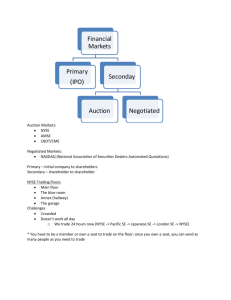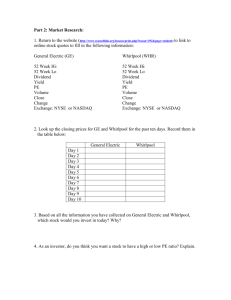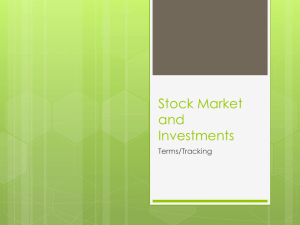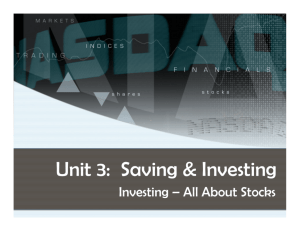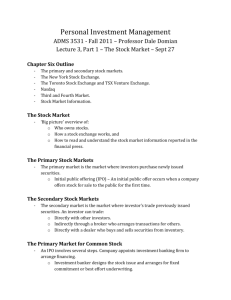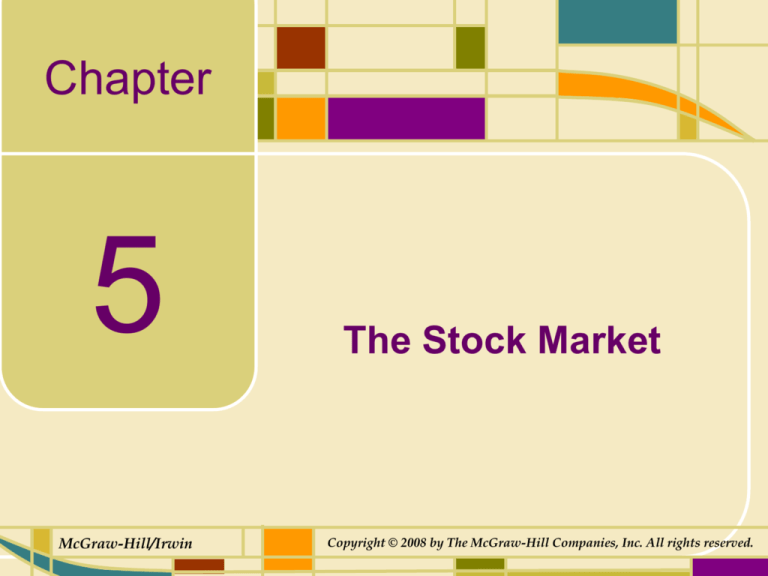
Chapter
5
McGraw-Hill/Irwin
The Stock Market
Copyright © 2008 by The McGraw-Hill Companies, Inc. All rights reserved.
The Stock Market
• Our goal in this chapter is to provide a “big picture”
overview of:
– Who owns stocks
– How a stock exchange works, and
– How to read and understand the stock market information
reported in the financial press.
5-2
The Primary and Secondary Stock Markets
• The Primary market is the market where investors
purchase newly issued securities.
– Initial public offering (IPO): An initial public offer occurs when a
company offers stock for sale to the public for the first time.
• The Secondary market is the market where investors
trade previously issued securities. An investor can trade:
– Directly with other investors.
– Indirectly through a broker who arranges transactions for others.
– Directly with a dealer who buys and sells securities from
inventory.
5-3
The Primary Market for Common Stock
• An IPO involves several steps.
– Company appoints investment banking firm to arrange financing.
– Investment banker designs the stock issue and arranges for fixed
commitment or best effort underwriting.
– Company prepares a prospectus (usually with outside help) and submits
it to the Securities and Exchange Commission (SEC) for approval.
Investment banker circulates preliminary prospectus (red herring).
• Upon obtaining SEC approval, company finalizes prospectus.
• Underwriters place announcements (tombstones) in newspapers
and begin selling shares.
5-4
IPO Tombstone
5-5
The Secondary Market for Common Stock, I.
• The bid price:
– The price dealers pay investors.
– The price investors receive from dealers
• The ask price:
– The price dealers receive from investors.
– The price investors pay dealers.
• The difference between the bid and ask prices is called
the bid-ask spread, or simply spread.
5-6
The Secondary Market for
Common Stock, II.
• Most common stock trading is directed through an
organized stock exchange or trading network.
• Whether a stock exchange or trading network, the goal is
to match investors wishing to buy stocks with investors
wishing to sell stocks.
5-7
The New York Stock Exchange
• The New York Stock Exchange (NYSE), popularly known
as the Big Board, celebrated its bicentennial in 1992.
• The NYSE has occupied its current building on Wall
Street since the early 1900’s.
• Today, the NYSE is a not-for-profit New York State
corporation.
5-8
NYSE Membership
• The NYSE has 1,366 exchange members. The exchange members
– Are said to own “seats” on the exchange.
– Collectively own the exchange, although it is managed by a professional
staff.
• The seats are regularly bought and sold.
– In 2005, a seat sold at a record price, $3 million.
– Seats can be leased, too.
– Both prospective buyers and leaseholders are closely scrutinized.
• Seat holders can buy and sell securities on the exchange floor
without paying commissions.
5-9
Types of NYSE Members, I.
• Over 500 NYSE members are commission brokers.
• Commission brokers execute customer orders to buy and sell stocks.
• Almost 500 NYSE members are specialists, or market makers.
• Market makers are obligated to maintain a “fair and orderly market”
for the securities assigned to them.
5-10
Types of NYSE Members, II.
• When commission brokers are too busy, they may
delegate some orders to floor brokers, or two-dollar
brokers, for execution.
– Floor brokers have become less important because of the
efficient SuperDOT system (designated order turnaround),
– SuperDOT allows orders to be transmitted electronically directly
to the specialist.
• A small number of NYSE members are floor traders,
who independently trade for their own accounts.
5-11
NYSE-Listed Stocks
• In 2005, stocks from about 2,800 companies were listed,
with a collective market value of about $13 trillion.
• An initial listing fee, as well as annual listing fees, is
charged based on the number of shares.
• To apply for listing, companies have to meet certain
minimum requirements with respect to
–
–
–
–
The number of shareholders
Trading activity
The number and value of shares held in public hands
Annual earnings
5-12
Operation of the New York Stock Exchange
• The fundamental business of the NYSE is to attract and process
order flow.
• In 2005, the average stock trading volume on the NYSE was just
over 1 billion shares a day.
• Volume breakdown:
– About one-third from individual investors
– Almost half from institutional investors.
– The remainder represents NYSE-member trading, mostly from
specialists acting as market makers.
5-13
NYSE Floor Activity
• There are a number of specialist’s posts, each with a roughly
figure-eight shape, on the floor of the exchange.
• At the telephone booths, commission brokers:
– Receive customer orders
– Walk out to specialist’s posts where the orders can be executed,
– Return to confirm order executions, and receive new customer orders.
• Coat colors indicate the person’s job or position.
5-14
Stock Market Order Types
5-15
NASDAQ, I.
• The name “NASDAQ” is derived from the acronym NASDAQ, which
stands for National Association of Securities Dealers Automated
Quotations system.
• NASDAQ is now a proper name in its own right.
• Introduced in 1971, the NASDAQ market is a computer network of
securities dealers who disseminate timely security price quotes to
Nasdaq subscribers.
• The NASDAQ has more companies listed than the NYSE.
• On most days, volume on the NASDAQ exceeds the NYSE volume.
5-16
NASDAQ, II.
• Nasdaq is an Over-the-counter (OTC) market: trading is almost
exclusively done through dealers who buy and sell securities for their
own inventories.
• NASDAQ is actually made up of two separate markets, the NASDAQ
National Market (NNM) and the NASDAQ SmallCap Market.
•
There are two key differences between the NYSE and NASDAQ:
• NASDAQ is a computer network and has no physical location
where trading takes place.
• NASDAQ has a multiple market maker system rather than a
specialist system.
• Like NYSE specialists, NASDAQ market makers use their inventory
as a buffer to absorb buy and sell order imbalances.
5-17
NASDAQ, III.
•
In 2005, there were about 500
competing NASDAQ dealers
(market makers), which amounts to
about 15 or so stocks per dealer.
•
In the late 1990s, the NASDAQ
system was opened to Electronic
Communications Networks (ECNs)
•
ECNs are basically websites that
allow investors to trade directly with
one another.
•
Buy and sell orders are transmitted
to the NASDAQ and displayed
along with market maker bid and
ask quotes.
•
One of the biggest ECNs is:
www.island.com
5-18
The NASDAQ System
• The NASDAQ network provides bid and ask prices as
well as recent transaction information.
• The bid and ask prices for the NASDAQ represent inside
quotes.
– The highest bid
– The lowest ask
• For a small fee, you can have access to “Level II” quotes.
– Displays all bids and asks
– Frequently displays the market maker identity
5-19
NYSE and NASDAQ Competitors
• The third market is an off-exchange market for securities listed on
an organized exchange.
• The fourth market is for exchange-listed securities in which
investors trade directly with one another, usually through a computer
network.
• For dually listed stocks, regional exchanges also attract substantial
trading volume.
5-20
Stock Market Information
• The most widely followed barometer of day-to-day stock
market activity is the Dow Jones Industrial Average
(DJIA), or “Dow” for short.
• The DJIA is an index of the stock prices of 30 large
companies representative of American industry.
5-21
The Dow Jones Industrial Average
5-22
Stock Market Indexes, I.
• Indexes can be distinguished in four ways:
–
–
–
–
The market covered,
The types of stocks included,
How many stocks are included, and
How the index is calculated (price-weighted, e.g. DJIA, versus
value-weighted, e.g. S&P 500)
• Stocks that do not trade during a time period cause index
staleness over that time period.
– That is, we do not know the "true" index level if all the stock
prices are not updated, i.e., fresh.
5-23
Stock Market Indexes, II.
• For a value-weighted index (i.e., the S&P 500), companies with
larger market values have higher weights.
• For a price-weighted index (i.e., the DJIA), higher priced stocks
receive higher weights.
– This means stock splits cause issues.
– But, stock splits can be addressed by adjusting the index divisor.
– Note: As of October 7, 2005, the DJIA divisor was a nice “round”
0.12493117!
5-24
Stock Market Indexes, III.
5-25
Example I: $1,000,000 to Invest,
Price-Weighted Portfolio
Company
Price
Price
Weight
Shares
to Buy
GM
40.56 0.3376
8,323
Nordstrom
25.91 0.2156
8,323
Lowe's
53.68 0.4468
8,323
120.150
1.000
8,323
Note: Shares = $1,000,000 / 99.370 = 10,063
5-26
Example II: Changing the Divisor
Day 1 of Index:
Company
GM
Nordstrom
Lowe's
Sum:
Index:
Price
40.56
25.91
53.68
120.15
40.05 (Divisor = 3)
Before Day 2 starts, you want to replace Lowe's with Home Depot, selling at $32.90.
To keep the value of the Index the same, i.e., 40.05:
GM
Nordstrom
Home Depot
Sum:
99.37 / Divisor = 40.05, if Divisor is:
40.56
25.91
32.90
99.37
2.481148564
What would have happened to the divisor if Home Depot
shares were selling at $65.72 per share?
5-27
Example III: $1,000,000 to Invest,
Value-Weighted Portfolio
Company
Price
Shares Capitalization Value Shares
(millions)
(millions)
Weight to Buy
GM
40.56
560.72
22,742.8
0.3323
8,192
Nordstrom
25.91
136.07
3,525.6
0.0515
1,988
Lowe's
53.68
785.75
42,179.1
0.6162
11,480
Total: 120.150
Total:
68,447.4 1.0000
21,660
Note: Shares to Buy = $1,000,000*Weight / Price
5-28
Example IV: How Does the
Value-Weighted Index Change?
(Use Index
Example II.)
Day 1:
Day 2:
Using the Index from Example II:
Company
GM
Nordstrom
Home Depot
Company
GM
Nordstrom
Home Depot
Price
40.56
25.91
32.90
Total Shares
Market Capitalization
(millions)
(millions)
560.72
22,743
136.07
3,526
2370.00
77,973
Total MV(1):
104,241
Divisor (Set by Vendor):
104.2413769
Day 1 Index Level:
1000.00
Price
44.21
27.25
33.50
Total Shares
Market Capitalization
(millions)
(millions)
560.72
24,789
136.07
3,708
2370.00
79,395
Total MV(2):
107,892
Day 2 Index Level:
1035.02
5-29
The Day 3 Index Can be Calculated in Two Ways:
Day 3:
Company
GM
Nordstrom
Home Depot
Price
43.250
23.210
34.100
Day 3 Index
Total Shares
Market Capitalization
(millions)
(millions)
560.720
24,251.1
136.070
3,158.2
2,370.000
80,817.0
Total MV(3):
108,226.3
Total MV(2):
107,892.0
Day 2 Index Level:
1035.02
Day 3 Index Level:
1038.23
Total MV(1):
104,241.0
Day 3 Index Level:
1038.23
Market Value Day 3
Index Level Day 2
Market Value Day 2
or
Day 3 Index
Market Value Day 3
Index Level Day 1
Market Value Day 1
5-30
Useful Internet Sites
•
•
•
•
•
•
•
•
•
•
www.hoovers.com (information on Initial Public Offerings, or IPOs)
www.nyse.com (website for the New York Stock Exchange)
www.nasdaq.com (website for the NASDAQ)
www.island.com ( an electronic communication network)
averages.dowjones.com (The Dow Jones Industrial Average)
www.russell.com (the Russell Indexes)
www.barra.com (reference for “value” and “growth” indexes)
www.djindexes.com (reference for current divisor for the DIJA)
www.standardandpoors.com (website for S&P 500)
www.nni.nikkei.co.jp (website for Japan’s Nikkei 225 index)
5-31
Chapter Review, I.
• The Primary and Secondary Stock Markets
– The Primary Market for Common Stock
– The Secondary Market for Common Stock
– Dealers and Brokers
• The New York Stock Exchange
– NYSE Membership
– Types of Members
– NYSE-Listed Stocks
5-32
Chapter Review, II.
• Operation of the New York Stock Exchange
– NYSE Floor Activity
– Special Order Types
• NASDAQ
– NASDAQ Operations
– NASDAQ Participants
– The NASDAQ System
• NYSE and NASDAQ Competitors
5-33
Chapter Review, III.
• Stock Market Information
–
–
–
–
The Dow Jones Industrial Average
Stock Market Indexes
More on Price-Weighted Indexes
The Dow Jones Divisors
5-34


